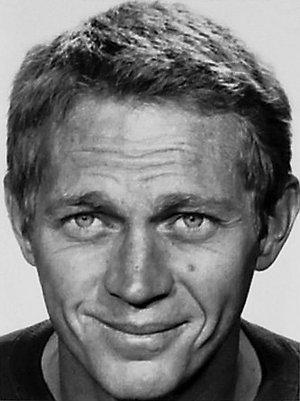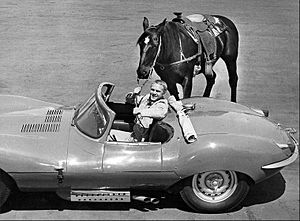Steve McQueen facts for kids
Quick facts for kids
Steve McQueen
|
|
|---|---|
 |
|
| Born |
Terence Steven McQueen
March 24, 1930 |
| Died | November 7, 1980 (aged 50) |
| Cause of death | Mesothelioma |
| Resting place | Pacific Ocean |
| Nationality | American |
| Occupation | Actor, film producer |
| Years active | 1953-1980 |
| Spouse(s) | Neile Adams (m. 1956-1972, divorced) Ali MacGraw (m. 1973-1978, divorced) Barbara Minty (m. 1980-1980, his death) |
| Children | Terry, Chad |
| Relatives | Steven R. McQueen (grandson) |
Steve McQueen (born March 24, 1930 – died November 7, 1980) was a famous American actor. He was known for playing tough, quiet characters, especially in action movies. He was also a passionate motorcycle and race car driver.
A Star on Screen
Steve McQueen became very famous in the 1960s. He starred in many popular movies that are still loved today.
Early Movie Success
In 1960, Steve McQueen starred in the Western movie The Magnificent Seven alongside Yul Brynner. This film helped him become a big star.
Just three years later, he appeared in another classic movie, The Great Escape (1963). In this film, he played a U.S. soldier held in a Nazi Prisoner of war camp.
Action Hero in the 1960s
The 1960s brought even more success for McQueen. He starred in films like The Cincinnati Kid (1965).
One of his most famous roles was in the action movie Bullitt (1968). In this film, he drove a powerful Ford Mustang through the streets of San Francisco. He even did many of his own driving stunts without a stunt driver!
Hits in the 1970s
In the early 1970s, McQueen had three more successful movies. These included The Getaway (1972), directed by Sam Peckinpah, and Papillon (1973), where he acted with Dustin Hoffman.
He also starred in The Towering Inferno (1974). In this movie, he played Chief O'Hallorhan, a fire department chief who led the rescue of people trapped in a burning building.
Awards and Nominations
Steve McQueen received four Golden Globe Award nominations for his roles in Love with the Proper Stranger (1964), The Sand Pebbles (1967), The Reivers (1969), and Papillon (1973).
He was also nominated for an Academy Award for his performance in the film The Sand Pebbles (1967).
Television Appearances
Before his big movie career, Steve McQueen was the star of the CBS Western TV series Wanted: Dead or Alive. He played Josh Randall, a bounty hunter, from 1958 to 1961, appearing in 94 episodes.
He also made guest appearances on other TV shows like Goodyear Television Playhouse, Studio One, The 20th Century-Fox Hour, Climax!, Wells Fargo, and Trackdown.
Racing and Stunts
Steve McQueen loved motorcycles and race cars. He was a very skilled driver and often performed his own stunts in movies.
Performing His Own Stunts
McQueen did many of his own stunts when he had the chance to drive in a movie. This included some of the exciting car chases in Bullitt and the famous motorcycle chase in The Great Escape.
Even though a professional stuntman named Bud Ekins did the famous jump over the fence in The Great Escape for insurance reasons, McQueen spent a lot of time riding his 650 cc Triumph TR6 Trophy motorcycle in the film. He was so good that in one scene, thanks to clever editing, it looks like McQueen in a German uniform is chasing himself on another bike!
Professional Racing Dreams
McQueen even thought about becoming a professional race car driver. In 1961, he raced a BMC Mini at Brands Hatch in the British Touring Car Championship, finishing third.
In 1970, he competed in the 12 Hours of Sebring race. Driving a Porsche 908/02 with Peter Revson, they won their class and almost won the entire race! Later that year, his production company, Solar Productions, used this same Porsche as a camera car for his movie Le Mans during the 1970 24 Hours of Le Mans race.
Off-Road Adventures
McQueen also loved off-road motorcycle racing. He often rode a BSA Hornet. He raced in many top off-road events on the West Coast, including the Baja 1000, the Mint 400, and the Elsinore Grand Prix.
In 1964, McQueen and Bud Ekins competed in the International Six Days Trial (ISDT) in East Germany. They were part of a team of American riders.
In 1978, Steve McQueen was honored by being inducted into the Off-road Motorsports Hall of Fame. He also helped fund the classic motorcycle documentary On Any Sunday (1971), where he was featured alongside racing legends.
His Amazing Car Collection
Steve McQueen owned many classic motorcycles and a collection of amazing and vintage cars. Some of these included:
- Race cars like the Porsche 917, Porsche 908, and Ferrari 512 from his Le Mans film.
- A 1963 Ferrari 250 GT Berlinetta Lusso.
- A 1956 Jaguar XKSS (which is now on display at the Petersen Automotive Museum in Los Angeles).
- A 1958 Porsche 356 Speedster 1600 Super, which he raced often.
- A 1968 Ford GT40 used in the Le Mans film.
- A 1967 Mini Cooper-S that he had specially customized.
- A 1952 Chevrolet 3800 pickup truck that he used for camping trips. This was the last car he rode in before he passed away.
McQueen tried many times to buy the Ford Mustang GT 390 he drove in Bullitt, but he was never able to. This famous car was later displayed at the 2018 North American International Auto Show and sold for a record $3.4 million in 2020.
Flying High
Besides cars and motorcycles, McQueen also loved to fly. He owned several aircraft, including a 1945 Stearman biplane and a 1931 Pitcairn PA-8 biplane that was once flown by the famous World War I flying ace Eddie Rickenbacker.
Later Life and Legacy
Steve McQueen passed away on November 7, 1980, at the age of 50. He died of heart failure. His passion for acting, racing, and adventure left a lasting mark on Hollywood and the world of motorsports.
Images for kids
See also
 In Spanish: Steve McQueen para niños
In Spanish: Steve McQueen para niños




